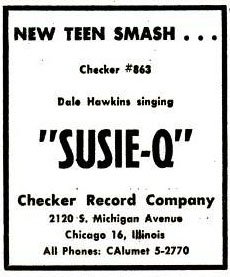
In June of 1968 Creedence Clearwater Revival scored their first chart hit with the double-sided single “Suzie Q,” which peaked at #11 and launched the quartet to national prominence. The swampy groove and timeless guitar lick have become so synonymous with CCR that you could be forgiven for assuming that it was penned by bandleader John Fogerty. But as anyone who bothered to pay attention to the liner notes on the original album or to the record label on the single could tell you, it was in fact written by the trio of Dale Hawkins, Stan Lewis, and Eleanor Broadwater. Sort of. We’ll get to that.

Born in Louisiana in 1936, Hawkins grew up immersed in the rich musical scene of the Shreveport area. His musical upbringing was informed equally by gospel, Delta blues, country and western, R&B, and pop among other styles. All of this fed into Hawkins’ playing style, known these days as swamp boogie mostly. After a brief stint in the Navy, Hawkins worked the club scene and started drawing attention to himself. A local DJ and producer spotted Hawkins’ band performing “Susie Q” and rushed them into the studio to cut it.
The session that led to the released version was held in the studios of a Shreveport, Louisiana radio station on February 14, 1957. The band consisted of Hawkins on guitar and vocals, Joe Osborne on bass, Ronnie Lewis on drums, and a 17-year-old James Burton, one of America’s greatest players and the Master of the Telecaster, on lead guitar. It was Burton who wrote and played that legendary guitar part.
Soon after its recording, “Susie Q” was bought by Chicago-based Checker Records, a subsidiary of the great Chess label. Checker released the single — alternately listed as “Susie Q” and “Susie-Q” — in May 1957 (b/w “Don’t Treat Me This Way”), but not before a bit of chicanery that was all too common back then.
According to an interview with Hawkins published in 2000, Checker surreptitiously added two names to the original publishing paperwork — Stan Lewis and Eleanor Broadwater. Their names also appear on subsequent pressings of “Susie Q,” all despite reportedly having nothing to do with the writing of the song. So who are they?
Well as a teenager, Hawkins worked in Stan’s Record Shop (yes, that Stan) and sang songs to the store’s customers, to the delight of Lewis. It just so happened that Lewis counted among his friends Leonard and Phil Chess of Chess (and Checker) Records. He was the one who connected Hawkins with the label, so at least he had some direct involvement with Hawkins. Broadwater, meanwhile, was the wife of a prominent Nashville disc jockey named Gene Nobles, and was granted a third of the songwriting credit as a thank-you to Nobles for promoting the song on his station. Record company cronyism at its finest.
Anyway, Billboard gave a positive review to “Susie Q” in its May 6, 1957 issue, calling it “another slower rhythm side that could go very well, especially with fanciers of the Deep South sounds.” That’s true enough, I suppose. More accurately, it’s an intoxicating blend of so-called swamp boogie and rockabilly. Far from the sanitized, polite pop that still ruled the airwaves, “Susie Q” is grimy, gritty, and oh-so catchy. So much so that Hawkins became one of many white artists mistaken for a black one, much to his delight.
“Susie Q” debuted on the charts on June 10, 1957 and enjoyed a nice run during that summer. It peaked at #27 on the best sellers list in the July 1 issue and appeared on the “Most Played by R&B Jockeys” chart on June 10. Hawkins released several more singles on the Checker label through 1960, but the closest he got to replicating his success was “La-Do-Dada,” which peaked at #32 in the fall of ’58.
Hawkins, who later spent time as a record producer, executive, and even hosted his own TV show, continued to record and perform actively until the end of his life. He died on February 13, 2010, from colon cancer in Little Rock, Arkansas.
Enrich your life and subscribe to the Before We Was Fab playlist on Spotify and Rdio today! For more Before We Was Fab entries, check out the archives.






Comments